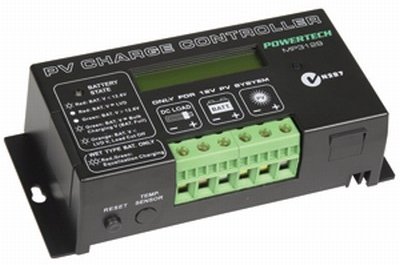charge controller

A charge controller, also called a charge regulator, is a device that controls the charging rate and/or state of charge for batteries. Wired between a solar array and a battery bank, its main job is to prevent the battery from being overcharged from the array and also from deep discharging, while monitoring the array and/or battery voltage. Both overcharging (which can lead to the electrolyte boiling) and deep discharging can permanently damage batteries.
To calculate the amp rating of a controller, use the formula amps × volts = watts (or watts/volts = amps). Thus, an 80-watt solar module charging a 12-volt battery should be regulated using a charge controller rated at 6.7A (80W/12V) or more. For small photovoltaic systems, charge regulators from 5 A to 30 A are available. Some of them can be used in both 12V and 24V DC systems. Another important parameter is the charge controller's efficiency percentage.
Types of charge controller
Various types of charge controller are available. These include simple switch on/off controllers, PWM (pulse-width modulated) charge controllers which charge the battery with constant voltage or constant current (the most commonly used controllers in PV systems), and MPPT (maximum power point tracking) controllers. The MPPT types are more costly and better suited to large systems where the investment in an expensive MPPT regulator gives quick returns.
Charge controller functioning is characterized by two different voltage thresholds, battery and module voltage, upon which the battery is charged. At higher voltage, typically 12.4V for 12V batteries, the charge controller switches the load to the battery. At lower voltage, typically 11.5V, the controller switches the load off. Some controllers allow manual setting of these thresholds. Alternatively, you can adjust the battery type to lead-acid or gel type, and the controller will adjust the two voltage thresholds automatically according to the battery type without degrading the performance.
If excessive ambient temperature swings of more than 5°C are expected, temperature compensated charge regulator electronics should be used.
